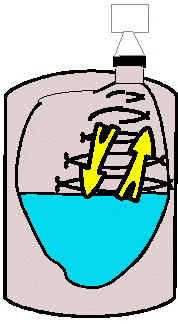The two technologies on the market are frequency modulated continuous wave (FMCW) or pulsed wave time of flight.
Pulsed Wave systems emit a microwave burst towards the process material, this burst is reflected by the surface of the material and detected by the same sensor which now acts as a receiver.
Level is inferred from the time of flight (transmission to reception) of the microwave signal. Microwave “echoes” are evaluated by sampling and building up a historical profile of the echoes.
FMCW systems, however, continuously emit a swept frequency signal and distance is inferred from the difference in frequency between the transmit and receive signals at any point in time.
FMCW is therefore the only method that is suitable for the high accuracy’s demanded for tank gauging.
Radar Level Sensor Theory

Advantages
This non-contact technology produces highly accurate measurements in storage tanks and some process vessels. Radar is an excellent, but fairly expensive technology (£1k to £5k per measurement) for continuous level measurements.
Several manufacturers have reduced the cost/price of the technology with various process radar offerings. These systems do not have the accuracy (and associated cost) of radar used for inventory control. In conclusion, radar can be highly accurate, is immune to most vapours / physical characteristics of the measured media, other than, in some cases, dielectric constant.
Disadvantages
It’s primary disadvantage is cost, which can be justified for tank gauging and inventory control. The pressure ratings on radar antenna are limited and these devices cannot measure interfaces.
Pulse radar has difficulty making accurate measurement when the media is in close proximity to the antenna because the time difference between send and return signals is too fast to measure accurately.
Practical Notes
In the case of hydrocarbons, an accurate water bottoms measurement must be made for precise inventory control. Typically, another technology, such as RF Admittance is used to make the interface measurement between water and hydrocarbons.
Some installations, such as floating roof tanks, require the installation of a stillpipe. Inconsistencies on the internal surface of the stillpipe can cause erroneous echoes, these can have an adverse effect on the accuracy of some vendor’s equipment.